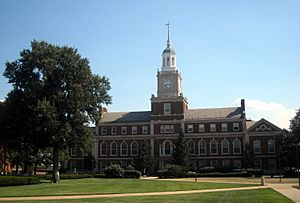Moorland–Spingarn Research Center facts for kids
The Moorland–Spingarn Research Center (MSRC) is a very important place in Washington, D.C.. It's located at Howard University and is like a giant treasure chest of history. The MSRC collects and keeps records about the history and culture of people of African descent from all over the world. It helps researchers learn about the Black experience, continuing a long tradition that started when Howard University first began.
Contents
History
How the MSRC Started
In 1914, a Black scholar named Jesse E. Moorland gave his amazing collection of books and materials to Howard University. This was a big step for African Americans to lead in documenting their own history. His gift helped bring together other Black-related materials at the University Library, forming what was called The Moorland Foundation.
Later, in 1946, Howard University bought the large personal library of Arthur B. Spingarn. He was a lawyer, activist, and a big collector of books by Black authors. The Moorland–Spingarn Research Center is named after these two important people. Their collections created the strong foundation for everything that came later.
Growing the Collection
Many librarians helped the Moorland Foundation grow. But a new era began in 1930 when Dorothy B. Porter (later Dorothy B. Porter Wesley) was appointed. For over 40 years, Dr. Porter Wesley helped the collection expand a lot. She created new ways to organize materials and developed helpful research tools.
In 1973, the collections were reorganized and became the Moorland–Spingarn Research Center. Dr. Michael R. Winston became its first director. Under his leadership, new sections were created, like the Library and Manuscript Divisions. The Howard University Museum and Howard University Archives were also started. These new programs focused on finding, getting, keeping safe, researching, and showing materials. This helped turn the special collections into a modern archive, manuscript center, and museum.
Today, the MSRC is working to make more of its materials available online. They also plan more public programs and research projects. This includes publishing the research done by their staff and other scholars.
Divisions
The MSRC is divided into different sections, each focusing on a special type of historical material.
The Library Division
The Library Division has over 175,000 books, pamphlets, magazines, and microfilms in many languages. These provide lots of information about the history and struggles of people of African descent.
This library holds many rare books, some from the 1500s. These include works by famous people like Juan Latino, Gustavus Vassa, Phillis Wheatley, and Frederick Douglass. The collection is especially strong in first editions by important writers from the early 1900s to today. These include W.E.B. Du Bois, Richard Wright, Alice Walker, Toni Morrison, and James Baldwin.
The Library Division also has special resources like:
- Papers written by students from other universities about Black-related topics.
- Newspapers and magazines from different countries that show the Black experience over time.
- A large collection of thousands of folders with information about people and events. Sometimes, these folders are the only source of information available.
Manuscript Division
The Manuscript Division helps us understand the growth of Black families, groups, and institutions. It also shows the ongoing fight for civil rights and justice. This division was organized in 1974 into four departments: Manuscripts, Prints and Photographs, Oral History, and Music. These collections of original documents add to the Library Division's resources. They also broaden the areas for research on the Black experience.
Manuscript Department
The Manuscript Department has over 18,000 feet of historical documents. These provide lots of information about African American life and history. More than 650 collections are available for research. These collections include letters, photos, diaries, scrapbooks, writings, and personal items. They belong to important figures like Alain Locke, Frederick Douglass, Mary Church Terrell, and Paul and Eslanda Robeson.
Prints and Photographs Department
The Prints and Photographs Department has over 150,000 images for study, research, and display. These include photos, slides, postcards, posters, prints, and maps. These works date from the 1800s to today. They feature drawings, sketches, and early types of photographs.
Music Department
The Music Department has many documents about Black people's contributions to jazz, folk, spiritual, popular, and classical music. Its collections are rich in sheet music, recordings, songbooks, and teaching materials for voice and piano. The collection includes works by over 400 composers from the 1700s to today.
Oral History Department
The Oral History Department has important documents about the Civil Rights era. The Ralph J. Bunche Oral History Collection has over 700 written interviews. These give valuable insights into the thoughts and actions of people who were part of this important time in American history. Other collections focus on women, Howard University, African American military history, and stories from people who donated their papers.
The Howard University Archives and Museum
The Howard University Archives is a safe place for the official records of the University. This includes files from schools, colleges, and departments, university publications, and papers written by Howard students. It also has materials showing the contributions of Howard alumni to society. The Archives provides information on the history of Howard University and its important people. It uses the Howard University Museum to show off University items and souvenirs.
The Museum focuses on showing Black history and culture through visuals. It displays the many resources from the Research Center's special collections. It also collects items that help explain the Black experience in a broad way.
Digital Production Center
In 2013, the MSRC started a new chapter by creating an official digitization program. Through the Digital Production Center, the MSRC saves and shares its historical records with the world. This digital program also manages the Digital Howard online library. This platform currently hosts the digital collections from the MSRC. Digital Collections include the archives of Anna J. Cooper and Howard University's namesake Oliver Otis Howard. It also has the Thomas Montgomery Gregory Military Collection and a collection of 6,000 old photo negatives.
See also


